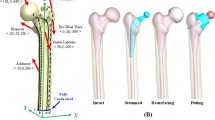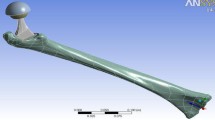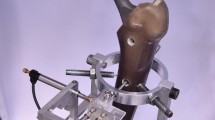Abstract
This study presents the numerical analysis of stem fixation in hip surgery using with/without cement methods since the use of cement is still controversial based on the clinical studies in the literature. Many different factors such as stress shielding, aseptic loosening, material properties of the stem, surgeon experiences etc. play an important role in the failure of the stem fixations. The stem fixation methods, cemented and uncemented, were evaluated in terms of mechanical failure aspects using computerized finite element method. For the modeling processes, three dimensional (3D) femur model was generated from computerized tomography (CT) images taken from a patient using the MIMICS Software. The design of the stem was also generated as 3D CAD model using the design parameters taken from the manufacturer catalogue. These 3D CAD models were generated and combined with/without cement considering the surgical procedure using SolidWorks program and then imported into ANSYS Workbench Software. Two different material properties, CoCrMo and Ti6Al4V, for the stem model and Poly Methyl Methacrylate (PMMA) for the cement were assigned. The material properties of the femur were described according to a density calculated from the CT images. Body weight and muscle forces were applied on the femur and the distal femur was fixed for the boundary conditions. The calculations of the stress distributions of the models including cement and relative movements of the contacts examined to evaluate the effects of the cement and different stem material usage on the failure of stem fixation. According to the results, the use of cement for the stem fixation reduces the stress shielding but increases the aseptic loosening depending on the cement crack formations. Additionally, using the stiffer material for the stem reduces the cement stress but increases the stress shielding. Based on the results obtained in the study, even when taking the disadvantages into account, the cement usage is more suitable for the hip fixations.


Similar content being viewed by others
References
Huddleston HD (1988) Femoral lysis after cemented hip arthroplasty. J Arthroplasty 3:285–297
Harris WH, Mcgann WA (1986) Loosening of the femoral component after use of the medullary-plug cementing technique—follow-up note with a minimum 5-year follow-up. J Bone Joint Surg Am 68a:1064–1066
Unnanuntana A, Dimitroulias A, Bolognesi MP, Hwang KL, Goodman SB, Marcus RE (2009) Cementless femoral prostheses cost more to implant than cemented femoral prostheses. Clin Orthop Relat R 467:1546–1551
Khanuja HS, Vakil JJ, Goddard MS, Mont MA (2011) Cementless femoral fixation in total hip arthroplasty. J Bone Joint Surg Am 93a:500–509
Bordini B, Stea S, De Clerico M, Strazzari S, Sasdelli A, Toni A (2007) Factors affecting aseptic loosening of 4750 total hip arthroplasties: multivariate survival analysis. BMC Musculoskelet Disord 8:69
Makela KT, Eskelinen A, Pulkkinen P, Paavolainen P, Remes V (2008) Total hip arthroplasty for primary osteoarthritis in patients fifty-five years of age or older. An analysis of the Finnish arthroplasty registry. J Bone Joint Surg Am 90:2160–2170
Hailer NP, Garellick G, Karrholm J (2010) Uncemented and cemented primary total hip arthroplasty in the Swedish Hip Arthroplasty Register Evaluation of 170,413 operations. Acta Orthop 81:34–41
Weiss RJ, Hailer NP, Stark A, Karrholm J (2012) Survival of uncemented acetabular monoblock cups: evaluation of 210 hips in the Swedish Hip Arthroplasty Register. Acta Orthop 83:214–219
Smith AJ, Dieppe P, Howard PW, Blom AW, National Joint Registry For E, Wales (2012) Failure rates of metal-on-metal hip resurfacings: analysis of data from the National Joint Registry for England and Wales. Lancet 380:1759–1766
Havelin LI, Engesaeter LB, Espehaug B, Furnes O, Lie SA, Vollset SE (2000) The Norwegian Arthroplasty Register: 11 years and 73,000 arthroplasties. Acta Orthop Scand 71:337–353
Sueyoshi T, Berend ME, Meding JB, Malinzak RA, Lackey WG, Ritter MA (2015) Changes in femoral stem geometry reduce intraoperative femoral fracture rates in total hip replacement. Open J Orthop 5:115–119
Lucht U (2000) The Danish Hip Arthroplasty Register. Acta Orthop Scand 71:433–439
Eskelinen A, Remes V, Helenius I, Pulkkinen P, Nevalainen J, Paavolainen P (2005) Total hip arthroplasty for primary osteoarthrosis in younger patients in the Finnish arthroplasty register—4661 primary replacements followed for 0–22 years. Acta Orthop 76:28–41
Hooper GJ, Rothwell AG, Stringer M, Frampton C (2009) Revision following cemented and uncemented primary total hip replacement: a seven-year analysis from the New Zealand Joint Registry. J Bone Joint Surg British Vol 91:451–458
Makela KT, Matilainen M, Pulkkinen P, Fenstad AM, Havelin L, Engesaeter L, Furnes O, Pedersen AB, Overgaard S, Karrholm J, Malchau H, Garellick G, Ranstam J, Eskelinen A (2014) Failure rate of cemented and uncemented total hip replacements: register study of combined Nordic database of four nations. Bmj-Brit Med J 348:f7592
Abdulkarim A, Ellanti P, Motterlini N, Fahey T, O’byrne JM (2013) Cemented versus uncemented fixation in total hip replacement: a systematic review and meta-analysis of randomized controlled trials. Orthop Rev (Pavia) 5:e8
Meding JB, Ritter MA, Davis KE, Hillery M (2016) Cemented and uncemented total hip arthroplasty using the same femoral component. Hip Int 26:62–66
Ramos A, Completo A, Relvas C, Simoes JA (2012) Design process of a novel cemented hip femoral stem concept. Mater Des 33:313–321
Ramos A, Simoes JA (2009) The influence of cement mantle thickness and stem geometry on fatigue damage in two different cemented hip femoral prostheses. J Biomech 42:2602–2610
Kayabasi O, Ekici B (2007) The effects of static, dynamic and fatigue behavior on three-dimensional shape optimization of hip prosthesis by finite element method. Mater Design 28:2269–2277
Senalp AZ, Kayabasi O, Kurtaran H (2007) Static, dynamic and fatigue behavior of newly designed stem shapes for hip prosthesis using finite element analysis. Mater Des 28:1577–1583
Rho JY, Hobatho MC, Ashman RB (1995) Relations of mechanical-properties to density and Ct numbers in human bone. Med Eng Phys 17:347–355
Higa M, Tanino H, Nishimura I, Mitamura Y, Matsuno T, Ito H (2015) Three-dimensional shape optimization of a cemented hip stem and experimental validations. J Artif Organs 18:79–85
Norman TL, Shultz T, Noble G, Gruen TA, Blaha JD (2013) Bone creep and short and long term subsidence after cemented stem total hip arthroplasty (THA). J Biomech 46:949–955
Oshkour AA, Davoodi MM, Abu Osman NA, Yau YH, Tarlochan F, Abas WaBW (2013) Finite element analysis of circumferential crack behavior in cement-femoral prosthesis interface. Mater Design 49:96–102
Ramaniraka NA, Rakotomanana LR, Leyvraz PF (2000) The fixation of the cemented femoral component—effects of stem stiffness, cement thickness and roughness of the cement-bone surface. J Bone Joint Surg Br 82b:297–303
Oshkour AA, Abu Osman NA, Bayat M, Afshar R, Berto F (2014) Three-dimensional finite element analyses of functionally graded femoral prostheses with different geometrical configurations. Mater Design 56:998–1008
Rancourt D, Shiraziadl A, Drouin G, Paiement G (1990) Friction properties of the interface between porous-surfaced metals and tibial cancellous bone. J Biomed Mater Res 24:1503–1519
Chen WP, Tai CL, Lee MS, Lee PC, Liu CP, Shih CH (2004) Comparison of stress shielding among different cement fixation modes of femoral stem in total hip arthroplasty—a three-dimensional finite element analysis. J Med Biol Eng 24:183–187
Goshulak P, Samiezadeh S, Aziz MS, Bougherara H, Zdero R, Schemitsch EH (2016) The biomechanical effect of anteversion and modular neck offset on stress shielding for short-stem versus conventional long-stem hip implants. Med Eng Phys 38:232–240
Bergmann G, Deuretzbacher G, Heller M, Graichen F, Rohlmann A, Strauss J, Duda GN (2001) Hip contact forces and gait patterns from routine activities. J Biomech 34:859–871
Duda GN, Schneider E, Chao EYS (1997) Internal forces and moments in the femur during walking. J Biomech 30:933–941
Jasty M, Bragdon C, Burke D, Oconnor D, Lowenstein J, Harris WH (1997) In vivo skeletal responses to porous-surfaced implants subjected to small induced motions. J Bone Joint Surg Am 79a:707–714
Ridzwan MIZ, Shuib S, Hassan AY, Shokri AA, Ibrahim MM (2007) Problem of stress shielding and improvement to the hip implant designs: a review. J Med Sci 7:460–467
Bitsakos C, Kerner J, Fisher I, Amis AA (2005) The effect of muscle loading on the simulation of bone remodelling in the proximal femur. J Biomech 38:133–139
Crowninshield RD, Pedersen DR, Brand RA, Johnston RC (1983) Analytical support for acetabular component metal backing. Hip 1983:207–215
Friedman RJ, Black J, Galante JO, Jacobs JJ, Skinner HB (1994) Current concepts in orthopaedic biomaterials and implant fixation. Instr Course Lect 43:233–255
Morshed S, Bozic KJ, Ries MD, Malchau H, Colford JM (2007) Comparison of cemented and uncemented fixation in total hip replacement—a meta-analysis. Acta Orthop 78:315–326
Wroblewski BM (1982) Fractured stem in total hip replacement. A clinical review of 120 cases. Acta Orthop Scand 53:279–284
Pellicci PM, Wilson PD, Sledge CB, Salvati EA, Ranawat CS, Poss R (1982) Revision total hip-arthroplasty. Clin Orthop Relat R 170:34–41
Wirtz DC, Schiffers N, Pandorf T, Radermacher K, Weichert D, Forst R (2000) Critical evaluation of known bone material properties to realize anisotropic FE-simulation of the proximal femur. J Biomech 33:1325–1330
Peng L, Bai J, Zeng XL, Zhou YX (2006) Comparison of isotropic and orthotropic material property assignments on femoral finite element models under two loading conditions. Med Eng Phys 28:227–233
Acknowledgements
This work is supported by the Scientific Research Projects Unit of Kocaeli University under project no. 2015/098 and 2015/074HD. The corresponding author thanks The Scientific and Technological Research Council of Turkey (TUBITAK) 2211-C Scholarship program.
Author information
Authors and Affiliations
Corresponding author
Ethics declarations
Conflict of interest
The authors declare that there is no conflict of interest regarding the publication of this paper.
Ethical approval
Ethics appproval is not required for this study.
Rights and permissions
About this article
Cite this article
Çelik, T., Mutlu, İ., Özkan, A. et al. The effect of cement on hip stem fixation: a biomechanical study. Australas Phys Eng Sci Med 40, 349–357 (2017). https://doi.org/10.1007/s13246-017-0539-1
Received:
Accepted:
Published:
Issue Date:
DOI: https://doi.org/10.1007/s13246-017-0539-1




